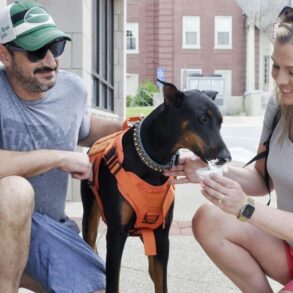
“2024 presented unique challenges for American pets and their owners. From devastating hurricanes to wildfires and severe storms, our animal companions found themselves particularly vulnerable during these crises. According to our comprehensive research, more than 1.7 million pets were reported lost nationwide in just one year—and it’s not just cats and dogs. Approximately 142,000 other animals became separated from their owners as well.”
I recently read “Lost Pets in America: The 2024 Report,” quoted above, which focused on animal companions who, for one reason or another, wound up on their own, and what became of them.1 I immediately recalled a piece I wrote some years ago—”Everyone Wants a Lost Dog Found“—which itself was based on an article in the New York Times about Bailey, a two-and-a-half-year-old goldendoodle, who had gone missing in Brooklyn. Her human, Orna Le Pape, was understandably distraught, and numerous strangers got involved in the search for Bailey. Why would people interrupt their busy lives to do this? One of Le Pape’s friends weighed in: “At a time like this, when there’s so much turmoil going on around the election, here’s this story that everyone can latch on to and be on the same side. Everyone wants a lost dog found.”
Because so many people deeply care about lost dogs and other animals, I was shocked by the sheer number who wind up on their own. It never dawned on me to write about it in my book, Dogs Demystified: An A-to-Z Guide to All Things Canine, simply because I was unaware of how many dogs and other animals become lost souls and how few are successfully rehomed. When I talked with a number of people about this situation, not a single one was aware of the scope of this tragic situation. They all encouraged me to write about it because perhaps if more people knew about it they would do more to prevent it from happening to their own nonhuman companions or those who live with others—and perhaps they would be more on the lookout for individuals who are acting as if they’re lost and pay more attention to unfamiliar animals in general.
Key Facts About Lost Pets in the U.S. in 2024
Here is a summary of what we know about the 1.7 million dogs and cats who were lost in the United States in 2024. The study, conducted by Pet911, consisted of an analysis of lost and found pet data throughout 2024. Researchers analyzed more than 1 million pet listings from their database and social media and supplemented this with interviews with pet owners, volunteers, and industry experts. Their goal was to “identify key patterns and insights that can help pet owners better understand risks and take proactive measures to protect their beloved companions.”
- There were more than 1.7 million lost pets nationwide.
- 63% of lost dogs and 52% of lost cats were successfully recovered.
- Texas had the most cases of lost dogs: 82,515.
- New Jersey had the most cases of lost cats: 18,580.
- July is the most dangerous month for pets: 40% of losses occur during this month.
- Pets are most likely to go missing on Fridays.
- Huskies are the most frequently lost dog (7%).
- Siamese cats are the most frequently lost cat (8%).
- Montana, Connecticut, and South Dakota are the states with the lowest volunteer community engagement.
- Bella and Luna are the most popular names for lost pets.
- Breakdown by species: Dogs: 72% (1,219,520); Cats: 20% (346,095); Other animals: 8% (142,135)—Birds: 49%; Rabbits: 6%; Turtles: 6%; Horses: 4.8%; Ferrets: 3.5%
The researchers wrote about what they call a “regional divide.” Southern states consistently report higher numbers of lost dogs, while Northeastern states show significantly higher rates of lost cats. This geographical distribution raises important questions about regional pet ownership habits, housing conditions, and local hazards that may contribute to these patterns.
More detailed analyses showed a strong positive correlation between temperature and lost dog rates. Warmer southern regions consistently show higher probabilities of pet loss incidents. This difference is particularly dramatic: The rate of lost dogs in hot climate states is nearly twice the national state average. The colder it is outside, the less likely animals are to venture away from the warmth and comfort of homes.
A state-by-state analysis showed that dogs (75%) go missing three times more often in rural areas than in urban settings.
The day of the week also is important to consider. Pet dogs and cats are most likely to go missing on Fridays. There also are some interesting trends for seasonal losses of dogs and cats. July was the most dangerous month for pets, with more than 40% of all pet losses occurring during this peak summer period. Not surprisingly, there was a substantial 31% increase in lost dog reports on July 4, most likely due to fireworks, outdoor gatherings, disruptions in household routines, and increased environmental stress.
All in all, 45% of dogs and 40% of cats go missing during summer months. The second most dangerous season is spring, when 31% of dogs and 30% of cats disappear from their homes, while winter accounts for only 7% of dog losses and 8% of cat losses nationwide.
Lastly, there were no gender differences for dogs or cats. For lost dogs, 52% were males and 48% females and for cats, 51% were males and 49% females.
In addition to looking at data for lost pets, researchers also analyzed volunteer community engagement and learned that Montana, Connecticut, and South Dakota were the states with the lowest volunteer community engagement. The study didn’t rank states with the highest community involvement.
Why this study is so important
I found the data in this report to be extremely interesting, important—and disturbing I’m hoping that as people learn about the large number of dogs, cats, and other animals who go missing they will pay more attention to their own companions and also be on the lookout for individuals who behave as if they have little to no idea of where they are.
It’s highly likely that many, if not most people, have at some time seen a lost animal in need. I hope that knowing how often this occurs will get them to pay more attention to what they can do to increase the chances of successfully rehoming an animal.
This post was originally published on this site be sure to check out more of their content.













































